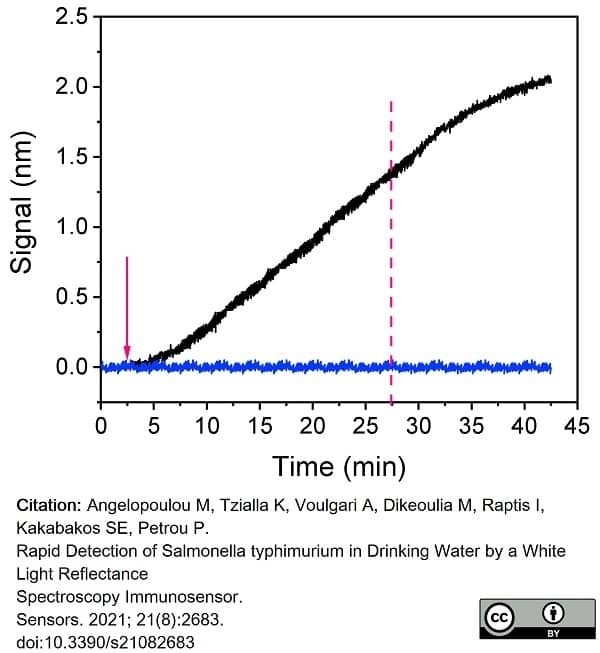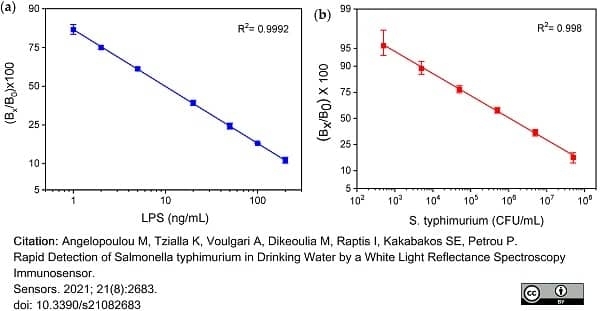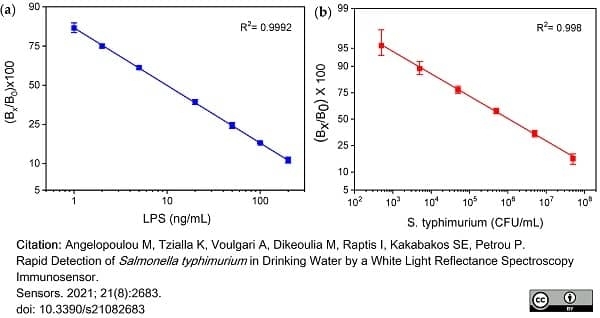Salmonella Group Antigen antibody




Rabbit anti Salmonella Group Antigen
- Product Type
- Polyclonal Antibody
- Isotype
- Polyclonal IgG
- Specificity
- Salmonella Group Antigen
| Rabbit anti Salmonella group antigen antibody recognizes a Salmonella group antigen. Salmonella is a genus of the family Enterobacteriaceae populated by a variety of Gram negative rod-shaped bacteria, many of which are pathogenic and cause a range of diseases in humans. Salmonellae possess 3 major surface antigens: the H or flagellar antigen (phase 1 and 2), the O or somatic antigen (part of the LPS moiety) and the Vi or capsular antigen (referred to as K in other Enterobacteriaceae). Salmonellae also possess the LPS endotoxin characteristic of Gram negative bacteria. This LPS is composed of an O polysaccharide (O antigen) an R core and the endotoxic inner Lipid A. Rabbit anti Salmonella group antigen antibody is polyvalent for Salmonella O and H antigens. Rabbit anti Salmonella group antigen antibody is unabsorbed and may cross react with related Enterobacteriaceae. |
- Target Species
- Bacterial
- Product Form
- Purified IgG - liquid
- Buffer Solution
- Phosphate buffered saline
- Preservative Stabilisers
- 0.1% Sodium Azide (NaN3)
- Immunogen
- Mixture of Salmonella enteriditis, S. typhimurium and S. heidelburg.
- Approx. Protein Concentrations
- IgG concentration 5.0 mg/ml
- Regulatory
- For research purposes only
- Guarantee
- 12 months from date of despatch
Avoid repeated freezing and thawing as this may denature the antibody. Storage in frost-free freezers is not recommended.
| Application Name | Verified | Min Dilution | Max Dilution |
|---|---|---|---|
| Immunofluorescence |
| Description | Product Code | Applications | Pack Size | List Price | Your Price | Quantity | |
|---|---|---|---|---|---|---|---|
| Goat anti Rabbit IgG (Fc):Biotin | STAR121B | E WB | 1 mg |
|
Log in | ||
| List Price | Your Price | ||||||
|
|
Log in | ||||||
| Description | Goat anti Rabbit IgG (Fc):Biotin | ||||||
| Goat anti Rabbit IgG (Fc):FITC | STAR121F | F | 1 mg |
|
Log in | ||
| List Price | Your Price | ||||||
|
|
Log in | ||||||
| Description | Goat anti Rabbit IgG (Fc):FITC | ||||||
| Goat anti Rabbit IgG (Fc):HRP | STAR121P | E WB | 1 mg |
|
Log in | ||
| List Price | Your Price | ||||||
|
|
Log in | ||||||
| Description | Goat anti Rabbit IgG (Fc):HRP | ||||||
| Goat anti Rabbit IgG (H/L):HRP | STAR124P | C E WB | 1 mg |
|
Log in | ||
| List Price | Your Price | ||||||
|
|
Log in | ||||||
| Description | Goat anti Rabbit IgG (H/L):HRP | ||||||
| Sheep anti Rabbit IgG:RPE | STAR35A | F | 1 ml |
|
Log in | ||
| List Price | Your Price | ||||||
|
|
Log in | ||||||
| Description | Sheep anti Rabbit IgG:RPE | ||||||
References for Salmonella Group Antigen antibody
-
Cloak, O.M. et al. (1999) Isolation and detection of Listeria spp, Salmonella spp and Yersinia spp using a simultaneous enrichment step followed by a surface adhesion immunofluorescent technique.
J Microbiol Methods. 39 (1): 33-43. -
Duffy, G. et al. (2000) A membrane-immunofluorescent-viability staining technique for the detection of Salmonella spp. from fresh and processed meat samples.
J Appl Microbiol. 89 (4): 587-94. -
Hunter, D.M. et al. (2010) Rapid detection and identification of bacterial pathogens by using an ATP bioluminescence immunoassay.
J Food Prot. 73: 739-46. -
Le, U.N. et al. (2011) Engineering and visualization of bacteria for targeting infarcted myocardium.
Mol Ther. 19 (5): 951-9. -
Ewald M et al. (2013) A robust sensor platform for label-free detection of anti-Salmonella antibodies using undiluted animal sera.
Anal Bioanal Chem. 405 (20): 6461-9. -
de Souza, S.O. et al. (2014) Osteomyelitis caused by Salmonella enterica serovar derby in boa constrictor.
J Zoo Wildl Med. 45 (3): 642-4. -
Kim, D.K. et al. (2014) Inverse agonist of estrogen-related receptor γ controls Salmonella typhimurium infection by modulating host iron homeostasis.
Nat Med. 20 (4): 419-24. -
Ewald, M. et al. (2015) A multi-analyte biosensor for the simultaneous label-free detection of pathogens and biomarkers in point-of-need animal testing.
Anal Bioanal Chem. 407 (14): 4005-13.
View The Latest Product References
-
Tian B et al. (2015) Blu-ray optomagnetic measurement based competitive immunoassay for Salmonella detection.
Biosens Bioelectron. 77: 32-39. -
Tian, B. et al. (2016) Multi-scale magnetic nanoparticle based optomagnetic bioassay for sensitive DNA and bacteria detection
Analytical Methods. 8 (25): 5009-16. -
Volpe, G. et al. (2016) Development and evaluation of an ELIME assay to reveal the presence of Salmonella in irrigation water: Comparison with Real-Time PCR and the Standard Culture Method.
Talanta. 149: 202-10. -
Tsougeni, K. et al. (2016) Plasma nanotextured polymeric lab-on-a-chip for highly efficient bacteria capture and lysis.
Lab Chip. 16 (1): 120-31. -
Cruz-Adalia, A. et al. (2016) T Cells Capture Bacteria by Transinfection from Dendritic Cells.
J Vis Exp. (107): e52976. -
Kastania, A. et al. (2017) Binding kinetics of bacteria cells on immobilized antibodies in microfluidic channels: Modeling and experiments
Sensors and Actuators B: Chemical. 253: 247-57. -
Farka, Z. et al. (2018) Prussian Blue Nanoparticles as a Catalytic Label in a Sandwich Nanozyme-Linked Immunosorbent Assay.
Anal Chem. 90 (3): 2348-54. -
Schenk, F. et al. (2018) Development of a paper-based lateral flow immunoassay for simultaneous detection of lipopolysaccharides of Salmonella serovars.
Anal Bioanal Chem. 410 (3): 863-8. -
Tsougeni, K. et al. (2019) A modular integrated lab-on-a-chip platform for fast and highly efficient sample preparation for foodborne pathogen screening
Sensors and Actuators B: Chemical. 288: 171-9. -
Tsougeni, K. et al. (2019) A modular integrated lab-on-a-chip platform for fast and highly efficient sample preparation for foodborne pathogen screening
Sensors and Actuators B: Chemical. 288: 171-9. -
Angelopoulou, M. et al. (2021) Rapid Detection of Salmonella typhimurium in Drinking Water by a White Light Reflectance Spectroscopy Immunosensor.
Sensors (Basel). 21 (8): 2683. -
Makhneva, E. et al. (2018) Cyclopropylamine plasma polymer surfaces for label-free SPR and QCM immunosensing of Salmonella
Sensors and Actuators B: Chemical. 276: 447-455. -
Moon, C.M. et al. (2020) In Vivo Bioluminescence Imaging for Targeting Acute Hypoxic/Ischemic Small Intestine with Engineered Salmonella typhimurium.
Mol Ther Methods Clin Dev. 18: 484-492.
- RRID
- AB_619545
8209-4006
If you cannot find the batch/lot you are looking for please contact our technical support team for assistance.
Please Note: All Products are "FOR RESEARCH PURPOSES ONLY"
View all Anti-Bacterial ProductsAlways be the first to know.
When we launch new products and resources to help you achieve more in the lab.
Yes, sign me up


